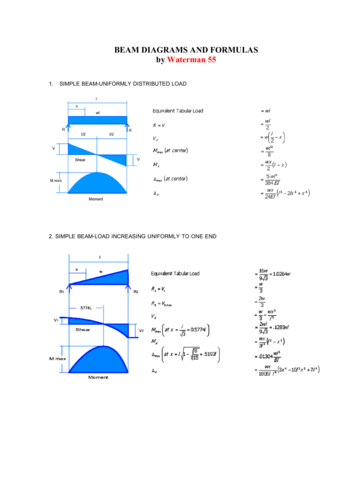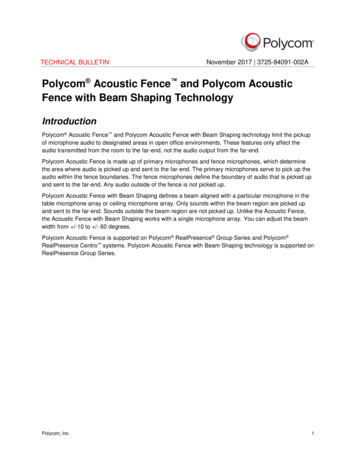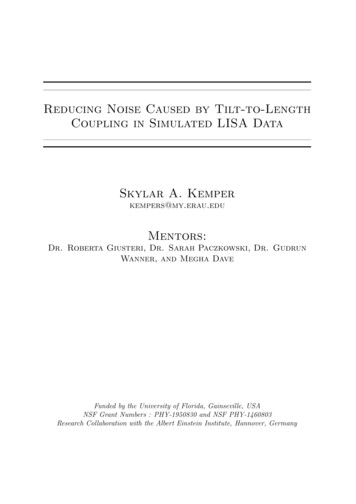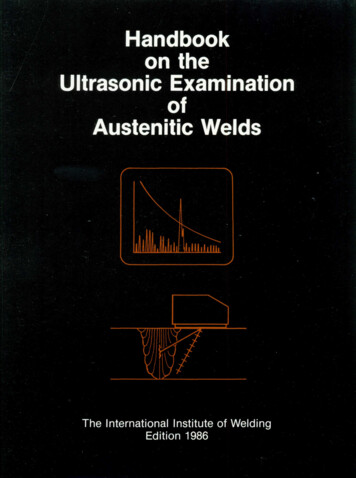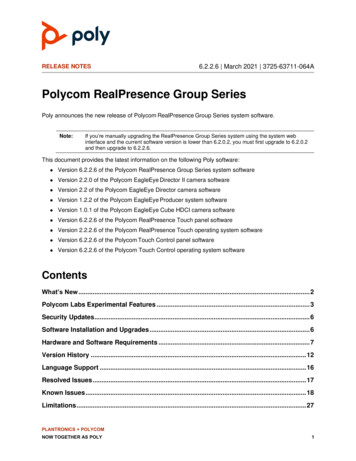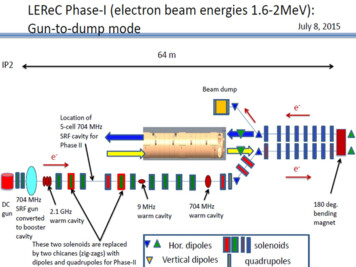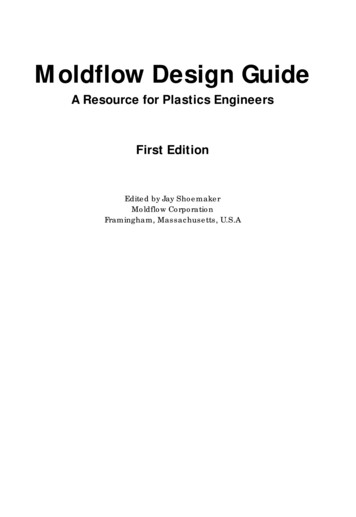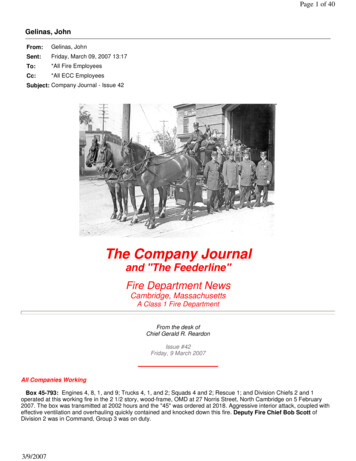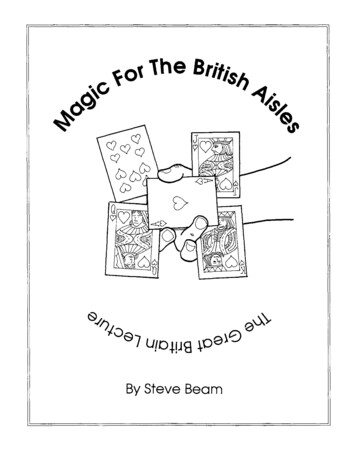
Transcription
By Steve Beam
count. "One." At this count, the first ace makes itsappearance. "Two." At this, a two appears instead ofthe second ace. "Whoops." The magician pauses forSteve Beamthe audience to appreciate his predicament. "It justOkay, so it has been long enough since you got even hotter." Another second, and the magicianhave had to wade through one of my effects. I'm finishes with a one-two punch. Make that a three-foursorry but the vacation is over. This is a quick four- punch. In the time it takes the magician to say "3-4"of-a-kind production, with a nice sucker start to it. It quickly, the two vanishes and is replaced by the otheris over in seconds, but the build-up adds a little three aces. "I passed!" (Try to resist the urge tolength. This is a great opener to any trick using the actually execute a pass as you deliver the last line.)The Work. Start with the top five cards of thefour aces. It's also performed entirely in the hands.Effect and Routine. "People are always pack arranged in the following order from the topasking me what it takes to become a magician. The down: two face down aces, two face up aces, and aanswer is simple. You have to go to magicians' face down deuce. Hold the deck in the left hand andschool. Andone ofthe hardestclasses is CardTricks obtain a break under the fifth card from the top. With454. The reason it is so tough is because ofthe final a back and forth movement of the pack, use your leftexam. I would like to re-create what happened to me forefinger to flip the top ace over the front edge of theduring my final exam. You'll have to watch closely, pack and onto the face of the pack as shown in figureit only takes a second. For the final exam, the heat 1. This is the first ace.Bring yourright hand over to the pack and takewas on. Literally, my professor turned the heat onso that my cards stick together. He sent me to the possession of the four cards above the break. You arefront of the class and he handed me an old, sticky, now going to do three things at once. As you slide theworn out deck ofcards . kindoflike this one that you cards above the break out to the right, your left thumbretains the top cardofthe four flush with the pack. Seeloaned me . thanks.He told me that he was going to counttofour.As he gave each count, he wanted me tofindanace.That is, at the count ofone, I was to produce thefirstace. At the count oftwo,the second ace. At the countofthree, the 'um . uh. that's right . the third ace.Give me a break, this wasn'tmath class. Atthe countoffour, the fourth ace. No roomfor error. Fourbeats,four aces. If I missed one ace, I was toast!This was one ofthe most difficult effects in all ofcardmagic. So difficult in fact, that if I was successful,I knew the rest ofthe class wouldburst into applause.So, here is what my final exam looked like. Wouldsomeone turn the heat up?Here goes! You may wish to count slowlywith me". The magician dramatically starts hisCUTTING CLASSCONTENTS -- MAGIC FOR THE BRITISH AISLESCutting ClassRub-A way Card VanishOptical IllusionColor Changing Card CaseThe Underhand ShuffleThe ShuffleBeam's Choice (with Michael Beam)Double DealerSucker Punch (Joe Mogar)The Macho Vanish (Joe Mogar)Written & Illustrated by Steve BeamInstigated by Tony GriffithEnglish Language Consultant: Anthony BrahamsOther Lectures by Steve Beam:Magic With No Entertainment Value, I & IITeaching An Old Deck New TricksVienna NotesCOPYRIGHT 1996 BY STEVEl\" L. BEAMPUBLISHED BY TRAPDOOR PRODUCTIONS2
figure 2. In order to keep from flashing the reversedcards which are now face up in the right hand, necktiethe pack and the packet as you rotate your righ t handpalm up to display it's three cards as one with thedeuce showing. See figure 3. Pause at this point sothat the audience appreciates your problem. At thecount of two, you have produced a two rather than anace. If they don't understand this, the rest of theproduction plummets in effectiveness.When you are ready to finish, bring your palmup right hand over to the left so that you can clip thetop card of the pack between the right third andfourth fingers as shown in figure 4.As soon as you have possession of that card,rotate your right hand palm down which flips the cardbetween your right third and fourth fingers face up.Without pausing, use your left thumb to pull the topcard of the three between your right thumb andsecond finger onto the top of the pack revealing thesecond, third, and fourth aces simultaneously to thequick count of 3-4. The pacing is important here. Itis, "I .2 .Whoops .It's getting hotter in here.34." It looks like the deuce explodes into the otherthree aces and the deuce is history. It is incrediblyvisual and magical. See figure 5.I use this as an opener to another ace trick.The professor said I could get extra credit if I couldcut to the four aces again, but this time I had to cutthem two at a time. I then go into my King Charlierfrom Magic, The Vanishing Art or How to Turna Trick For Fun & Profit (1979-out of print) andreprinted this year in Vienna Notes.Background. This was originally publishedin issue #59 oIThe Trapdoor. The fl ipoverflourish,used as a one card revelation, was published on page167 of Expert Card Technique as There It Is!According to them, "This is one of those amusingnovelties which spring up out ofnowhere and whichfor that reason cannotbe ascribed to any originator."3
Rub Away Vanish.Tips & Tweakspieces of handling for me. Note that while it is notnecessary to the execution of the move, I alwaysperform this while standing and therefore willdescribe it with those conditions.Tip #1: The Far Side. Choose a spot on thetable for the vanish to occur which is a stretch foryou. If you are standing, bend forward at the waist,and perform the move at least two feet from the neartable edge. This tends to put the card right undertheir collective noses but it serves several greaterpurposes which will become obvious in a moment. Ialso place the card slightly to the right of center onthe same vertical plane as my right shoulder.Tip #2: The Flash. Allow about a quarter ofan inch of the far right corner of the card to peek outfrom the right side of the hand as the card is tabled.This is shown in figure 1. Here is why. First, theaudience actually thinks it sees the selection on thetable for a moment. There is a retention of visionwith this corner. Even though if they watch thatcorner, it vanishes shortly.The second reason for the flash of the corneris that you are showing that the card is clearly locatedon the far right side of the hand. It is so far to theright, that it is peeking out the right side of the hand.It seems far more impossible that you could steal acard onto the pack which is on the left side of thehand if the card is on the right side. There is noquestion that the card is on the table.I am not one to become enamored withtechnique. I learn the sleights I like and try to perfectthem for my use. Since I have different mannerismsand gestures than others, not all my bits-o-techniqueare usable by others. However, there are a fewsleights which have become pets of mine over the lastthree decades. One of these is the uncreditedRub-ADub-Dub card vanish from Hugard and Braue'sExpert Card Technique. I have been doing themove essentially the same for the last twenty-plusyears, with several tweaks and variations which Ihave featured in my lectures since the seventies.The Original. The original move is veryeffective. The selected card is secretly controlled tothe top of the pack. The deck is held in the left handin dealing position. The magician double lifts,showing an indifferent card. Flipping it face down,he uses the left thumb to push it over the right edge'of the pack so that the long right edge rests on thetable top. He places the heel (the right side) of hisright hand on top of the right edge of the card asshown in figure 1.Pivoting the right hand on its right side, thehand is lowered onto the tabled card. The left handis removed, leaving the chosen card face down on thetable. After rubbing the card vigorously on the table,the card is turned over to show that it has changedinto the selection.The selected card is flipped face down ontothe top of the pack and the tabling sequence isrepeated. But this time, as the left hand is pulledaway from the table, the left thumb steals theselection back onto the top of the pack under coverof the falling righ t hand.That is basically the description as it appearsin the original source. For a book with technique inits title, there is conspicuously little of it here. This isa bare-bones description. One assumes that the lefthand continues to hold the pack and proceeds withother tricks at this point. The only real blow-off isthe setting-up of the audience with the color changebefore the vanish. Below, you will find various bits,some mutually exclusive, designed to sell this to anyaudience that will buy it. The following are notnecessarily the best pieces of handling, but the best4
deck on the table near the table edge to your left andimmediately move forward with yourleft hand whichyou place on top of your right. You will notice thatas you lean forward onto the deck with your armsactually taking some of the weight of your upperbody, your left forearm partially blocks the deckfrom the view of many of the audience. If you areperforming for an audience of one or two people,you can completely block the view of the deck. Thereason for blocking the view is to remove any heatfrom the true location of the card you are in theprocess of vanishing. The key phrase here is, "Out ofsight, out of mind."Tip #6: The Lean. One of the key pointshere is focus. You have two hands on the "card" asyou lean forward on it. Your whole body is focused,almost pointing, to the card that is supposed to be onthe table. Subliminally and subconsciously, youraudience believes that you would not be reachingway over to that location if there wasn't a reason.(Since your back is probably hurting at this point,you are probably wondering about the reasonsyourself.) There has to be a card there. Everythingpoints to that fact. This is the reason for the first fivetips. They synergize into a complete packagedemanding the audience believe that the card is onthe table.Tip #7: The Massage. With two hands onthe card (far stronger "pointing" than a single handdoing the work) you need to have a reason. Are yousimply covering the card from view? Why? Sincethe eye follows motion, you are going to draw theireyes to your hands (and further in degree away fromthe pack) with movement. Pretend to be grinding thecard into the mat with both hands.Tip #7: Time Misdirection. While yourback won't allow you to bend over for too long, youshould continue the massaging action for three tofour seconds. The longer the audience believes thecard is in this location, the more impressive thevanish. Also, the harder it will be to remember thatthe left hand once held both the card and the decktogether. Of course, time misdirection is assumed inthe original write-up in Expert Card Technique asit would be in all vanishes. As you rub the card intonothingness, pretend to be brushing away stubbornlittle remaining pieces with your fingertips.Tip #8: Facing Skyward. When youdeposited the deck on the table, it was face up due tothe wrist tum. This is one of the most importantWhile this is difficult to convey in print, Icould show you in seconds. Remember, the righthand butts up against the pack. It would not bedifficult to imagine that the card could be secretlymoved an inch to the left as the left hand wasremoved. It would appear to be more difficult (andthus less likely for a spectator to suspect it) for a cardto be moved the entire width of the right hand fromwhere it peeks out to the top of the pack. Thisappears to be far greater in distance than the threeinches that it is.Tip #3: Turning Point. In the original, theleft hand continued to hold the deck face down as itmoved to the left. You, on the contrary, are going toperform a wrist turn with your left hand as you moveit away. That is, you are going to rotate the left wristin a clockwise manner until the deck is face up andthe hand is palm down. This is part ofa much biggermisdirection package which will unfold momentarily,but in the short term it hides the left thumb'smovement better than the original. It is much harderto notice the left thumb's sudden recoil to the left ifit is not visible.Do not misunderstand. In the original, theleft thumb's journey is, for the most part, covered bythe right hand. However, there is a sharp differencein the before and after picture of the left thumb. Asthe right hand covers the card, the left thumb isextended to its farthest to the right. A second laterwhen the left hand emerges from under the righthand, the left thumb is curled tightly onto the pack.With a wrist turn, the left thumb's ending positionisn't visible to the audience.Tip #4: On the Diagonal. As your leftthumb retracts the card and the wrist executes awrist-turn, pull your left hand back at a 45 degreeangle toward the near comer of the table edge.Having approached the "sweet spot" on the table onthe diagonal, this communicates that your left handhas completed its journey and purpose by depositingthe card and is now returning to "your space."The action here should be similar to vanishesaccomplished by a fake transfer. In those, the righthand moves over to the left hand and pretends todeposit something and then returns to a naturalresting position as the left hand draws attention toitself with its movement. As you apparently table thecard, there should be a conscious relaxation of theleft arm.Tip #5: Dropping The Deck. Place the5
points of my handling of the move. You have justvanished a face down card, say a four. Once the cardis gone, the audience is looking for a card with twocharacteristics. It was a four and the last time it wasvisible, it was face down. The nearest object is astack of face up playing cards. They don't see anyface down cards anywhere. So what about a four.There is a face up indifferent card on the top of theface up pack. It is neither face down, nor a four.For the audience to suspect the deck, theywould have to make a fairly large mental leap. Theywould have to believe that you not only stole the cardback from the table but also managed to hide it underother cards. All I can tell you is that after performingthis move in the manner discussed above for most ofmy life, it is a leap the audience is not willingto make.With all the salesmanship I exercised when trying tolose my Fiat back in the eighties, you have knockedthem down and continued to kick them. They haveownership on that card's tabled location becausethey put it there themselves with their own thoughts.Of course you took every opportunity to make thatthe path ofleast resistance. This is dangerously closeto fraud and I hope your parents are proud of you.Variation #1: Face Up. There have been atleast two attempts to find a way of performing theRub-A-Dub-Dub or Rub Away Vanish with the cardto be vanished being held face up. The first you willfind in David Harkey's book, Simply Malarkey. Inhis method, you steal the face up card underneath thepack as the left hand comes away from the sweetspot. Jay Sankey published a version in StephenMinch's Spectacle which used a face up pack withthe card being stolen back onto the pack, butunderneath the new top card. In other words, thecard is stolen from the table to a position secondfrom the top of the pack.Since both of these handlings are based uponthe original vanish, it is understandable why theadditional effort is necessary to cover the face upcard. However, if you will perform the vanish asdescribed above, you will find that it is automaticallyhidden by the wrist-turn. At the conclusion of thevanish, the card is face down at the bottom of a faceup pack.Further, you will not believe this until you seeit performed, but there are no angles to be concernedwith. I frequently perform this surrounded and thereis nothing to see. Depending upon your angles to theright, you may have to adjust it slightly by startingyour wrist turn a fraction of a second sooner. That isthe only adjustment necessary to allow you toperform the vanish with a face up card.Variation #2: The Two-legged Table. Oneof my favorite routines is called Card Compression.It concludes with the vanish of a card using the RubAway Vanish. The rest of the trick can be performedwithout a table up until the finish which requires thetable for the vanish. I wanted to be able to do theroutine while performing in walk-around situationswhich greatly limited the availabilityof a performingsurface.Since this was back in the seventiesand earlyeighties, everyone was looking for magic that wasperformed in the hands of the audience. Magiciansare great at playing follow the leader, evenbestowing that name on a well-known card trick plotto commemorate the fact. So, in the seventies, youdidn't just make a coin disappear. Instead, throwthree coins with it into the spectator's hand. Then letthem count them in a moment to fmd they now onlyhold three coins leaving them to mathematicallyrealize (rather than visually realize) the vanish.Some great magic took a giant leap backward whenit was dropped into the hands of spectators.I developed the vanish further so that I couldperform it in a spectator's hand for times when therewas no table. I came up with similar misdirectiontechniques to the vanish above to solidifythe vanish.At some point later, Dan Garrett mentioned inM.U.M. that he had discovered that you couldperform the Rub-A-Dub-Dub vanish on someone'shands. Short of tracking Dan down like a fox in thewoods and then bludgeoning him into submission, Imust credit Dan for the move. I have been using it inmy lecture for the last decade or so with Dan'spermission (butdon'ttellDan.). Idon'trecallanytechnique surrounding the description of Dan'smove so I will provide you with the technique that Ideveloped.Ask to borrow a spectator's right hand. "Ineed a table for this. Poof. You're a table." Hishand will take the place of the table. Position it sothat it is opened flat and palm up. Hold the deck inyour left hand in dealing position. Push the top cardto the right of the pack as in the original. Lower theright edge of the card onto the line formed by his littlefinger. Bring your right hand over to cover the card.Your pinky is parallel to his, only the thickness of thecard separating them.6
performed this thousands of times and have neverhad a volunteer glance toward the deck in my lefthand. Think about it. After you have held his hand,you start checking out his body looking for the card.If you were him, what would you be thinking about?Enough said.Variation #3 - Leg Man. If you want toperform the vanish standing up and without a table,and you don't feel comfortable doing it on avolunteer's hand, this is for you. This variationallows you to do the move on your leg.Hold the deck face down in your left hand indealing position. Turn the top card face up. Lift yourright leg up slightly. Bring your left hand over to themiddle of the top of your thigh. Thumb the top cardover to the right. The deck should be directly in frontof the leg, about three inches. Bring your right handdown immediately in front of the the face up card.Now you are going to do two things simultaneously.As your left thumb pulls the top card back flush withthe pack, it also does a wrist turn to keep the top cardfrom being visible to the audience.The left hand comes to rest at your left sidewith the hand turned just enough to keep the cardfrom being visible. Massage the imaginary card onyour right thigh. When ready for the magic to occur,again you will do two things simultaneously. Asyour right hand mashes flat on your leg and youextend your right fingers showing the card hasdisappeared, your left hand quickly rotates the top ofthe deck toward the audience.This is too much for the mind to follow.They see you rubbing the card on your leg. Amoment later both hands make a simultaneousgesture and the card is face up on the pack in the lefthand. If you don't wish to reproduce the card, youcan do the vanish with the card face down. You canproceed to reproduce the card in any manner youwant to if you wish.Leftovers. That's all there is to it. Face up orface down. On the table, volunteer's hand, or yourown leg.Stand-up, seated, walk-around, orsurrounded. The move is incredibly versatile and canbe used whenever you need a card to disappear. Ifyou're wondering why I have spent so much timewith this, it's because good card vanishes --- unlikecoin vanishes, are hard to find. Since this is one ofthe few good vanishes, I wanted to be able to do itunder almost any conditions. Spend time with it andyou'll find it worth your while.Several things now happen simultaneously.Pivot your right hand down onto the card in his handusing your fourth finger as the pivot point. Justbefore your hand lands on the card, the left thumbdraws the thumb back onto the deck proper.You are now left with all the things that I toldyou earlier to try to eliminate. You are holding a facedown deck where they will look for the face downcard momentarily. You can't get much timemisdirection because your flesh is against his fleshand any illusion of there being a card there won'thold up for long. You can't table the deck becausethere is no table. Leaning forward would lookridiculous because you would end up kissing hischest. Massaging the imaginary card is liable to bringyour manhood into question and I'll remind you thatyour groin is currently within kicking distance of thevolunteer.So, how do you reduce the heat on the pack?Immediately bring your left hand under thespectator's forearm and lift his arm upward. Lift itup slowly and steadily. As soon as you reach the topof the lift (about the level of the top of your head)bring your right hand down on his palm and spreadyour fingers widely. This is the moment of thevanish. Note that the deck is out of his sight, hiddenby his own arm. Immediately pretend to be searchingfor the missing card by looking up his sleeve andinside his jacket. You may even ask him to turnaround so that you can see what he did with it.When I first came up with this, it was notdesigned to be magic in his hands. It was designed toallow the spectator to replace a table when one wasnot available. However, this is one of the strongestmagic experiences a spectator can have. He not onlysees the vanish, he feels the vanish. The volunteer isthe eyes and hands of the audience. When he isconvinced, the audience is convinced. You may feela little queasy about trying this for fear that itrequires too much nerve. You will be afraid that thevolunteer will feel the difference between the surfaceof your right hand and the surface of a playing card.It is not as bold as you suspect. Thevolunteer is the one under pressure. He isn't used tobeing in front of an audience. He is concentrating onthe instructions you are giving him, trying not to beembarrassed. Dividing his attention between theaudience, you, and the fact that a guy is holding hishand, is enough to keep his attention away from hispalm's sense of touch for a couple of seconds. I have7
IIOPTICAL ILLUSIONLEFT hand?" (Show hands empty.) "I already toldyou, it's left. It was an optical illusion. For thosethat didn' tfollow that last effect, I was going to havea handout. but I haven't finished with thefootnotes. Don't go away. I have another trickthat's even cornea than that one.Leftovers. For an alternative ending, youcan try the following. "Now I' IIplace the eye in thehand. You sir, would you keep an eye on the handthat holds the eye. I'll place the hand in the pocket.Where's the hand?" (They say "in the pocket")"NO, it's right here." (Shake empty left hand.)Don't roll your eyes. I like puns.Backwound. This is my expansion ofRoger Sherman's Eye Opener which was originallypublished in issue #43 ofThe Trapdoor.IIRemove a hand and an eyeball from yourpocket. Keep them in your hand so the audiencecannot see what you're holding."I'm here today to answer that questionwhich has plagued magicians, not only forcenturies, but also for hundreds of years. Is thehand really." [transfer the hand to the left hand]"quicker than the eye?" [Display the eye in the righthand. Table both of them.] "I have arranged atest." [Pick up the hand with your right hand andpretend to transfer it to the left hand.] "I'll place thehand over here & I'll ask you sir to keep an eye onthe hand that holds the hand. You sir," [pointing tosomeone else] "I'll ask to keep an eye on the handthat holds the eye." [Pick up the eye with your righthand and close your hand over it without exposingthe hand which is also in the right hand.] "Now if Irub them at the same time . using some eye-handcoordination . you'll see the hand leaves the handthat held the hand and joins the hand that holds theeye. proving conclusively that the hand is indeedquicker than the eye." [Open the hand dramaticallyand show that the hand has arrived in the right hand.Transfer the hand to the left hand while displayingthe eye in the right.]"But, as impressive as that is, I know whatyou're saying. You are saying that the eye didn'teven move. What did you expect? It's a lazy eye.Or, should I say, an energetically challenged eye?But this is a special eye. I have been training thiseye. And I might add, it made a heckuva pupil . Didreally well on its Eye-Q test. If he hadn't, he'd havegotten 50 lashes." [Table the eye with your righthand and transfer the hand to the right hand. Displaythe hand.]But this is no ordinary hand either. This is agood looking hand. Some might even call ithandsome. Not only that, it's a left hand. Thatshould help you keep track of it. And, that's a clueto the answer of the question I'm about to ask.Remember. LEFT. HAND. So I'll use my righthand to place the left hand in my left hand. [Pretendto place the hand into the left hand while retaining itin the right.] I'll get rid ofthe eye by placing itin thesocket. uh. Pocket." [Pick up the eye with theright hand and place it in your right pants pocketLeave the hand there also.]"Now where is theTHE COLOR CHANGINGCARD CASEThis effect is a great opener when doing cardtricks. It allows you to have magic happening before you even remove the cards from the case.While it is not impromptu, it can be prepared inabout two minutes and is set for an eternity.Effect. The magician tells the audience that hewants to show them a card trick. He pulls out a bluecard case and starts to open it to remove the cards."I was going to show you some 'blue' card tricks,but I see there are some children in the audience.so I'll show you some red card tricks instead." Hepoints to the blue card case as he says the above.When he vanishes talking, he tosses the case up intothe air where it instantly changes to a red case.An alternate presentation would be for the magician to remove a red-backed case and hold it overa red-backed close-up mat. "I didn't realize thatthe backs of the cards matched the color of the matso closely. That's a problem. Every time I hold thered cards in front of the red mat, the cards willseem to disappear. I think I have a solution."Preparation. The impact of this effect ismatched by the ease of performance. It is simple toset up and simple to perform. Start by obtaining ared and blue card case which are both of the samesize (poker versus bridge). You are going to cut offa portion of (for example) the blue case and glue itonto the red case. Take the blue case and either cut8
"-' - --':.:.:.:.:.:.:.:.:.:.: :.:.:.:.:.:.:.:.:.:.:.:.:::::::::::::::::::::;: . . . . . . . . - -1. . .1 1 1 1 1 1 1 1 1 1 . . . . . . . . f/I,performer's view, turn the illustration upside down.)You will notice that your thumb and fingerscover the red edges on top and bottom. The base ofyour hand covers the red half of the face of the case.The only edge you have to be careful about is theone on top of the flap of the card case. As long asthere is no one to your left, you won't have nay angles to worry about.Remember to be casual at this point. Since youhaven't yet removed the cards from the case, thespectators will not be watching that closely. Justremember to aim the false blue face of the case toward the spectators' line of vision.To execute the change, lower the hand in preparation for tossing the case into the air. As you do,or tear the section shown in figure 2. Figure 1 isthe blue case. Figure 2 is the piece you removefrom the blue case. Figure 3 is the red case and figure 4 is the finished card case gimmick. Use rubbercement when assembling to keep the card case fromwarping and use it sparingly. Apply to both surfacesyou plan to glue. Allow the cement to dry beforeattaching the surfaces.The Work. Start with the case in your rightcoat pocket with the gimmick facing outward andthe opening toward the front. Your right sideshould be turned slightly toward the audience.Reach into the pocket and take the case as shown infigure 5. This is the spectator's view. (To get the:.:.:.:.:.:.:.:.:.:.: . . . ;. . . . . .;,:.:.:.:.:.:.:.:.:.:.:;: ,-9
position the case so that you are holding it on thesame plane as the floor. The right hand completelyblocks the spectators' view of the case. See figure6.Now, as you start your upward motion with thedeck, pivot it outward so that the ungimmicked sideis facing the audience. Toss the deck in boomerangstyle, straight up about two to three feet in the air.The spectators will see an instant change from blueto red. Have your left hand ready to catch the falling object. As soon as you catch the case (anddon'tforget to catch the case) you should positi
15 hours ago · inissue #59 oITheTrapdoor. The flipoverflourish, . Fora book withtechnique in its title, there isconspicuouslylittle ofit here. This is a bare-bonesdescription. One assumes that the left . could show you in seconds.
